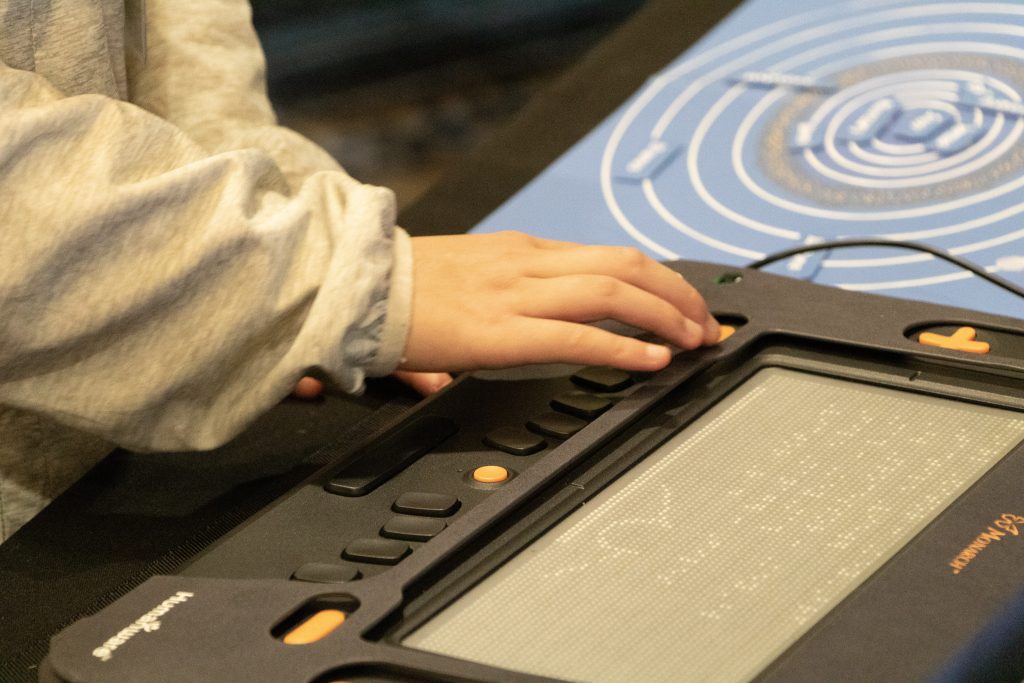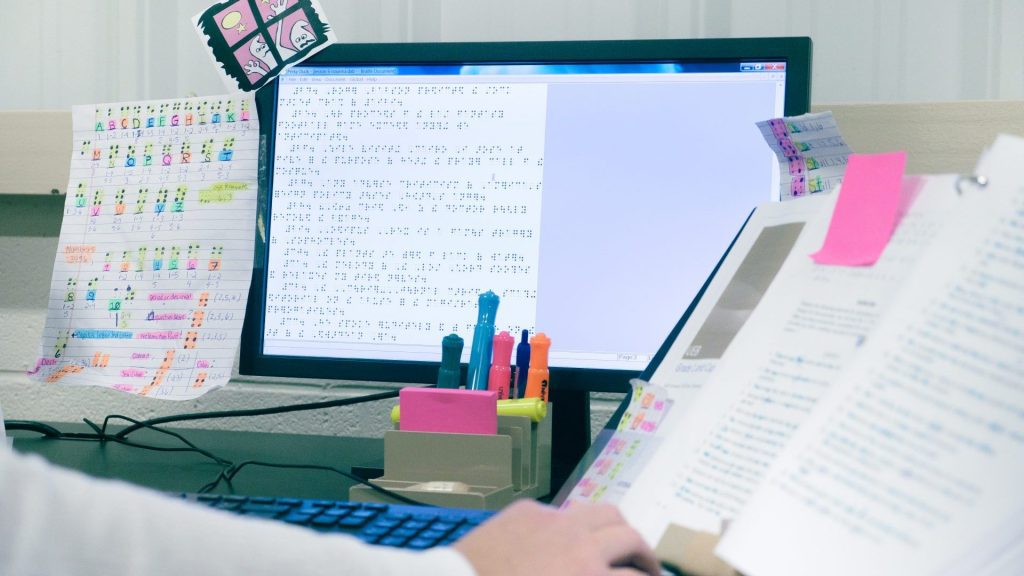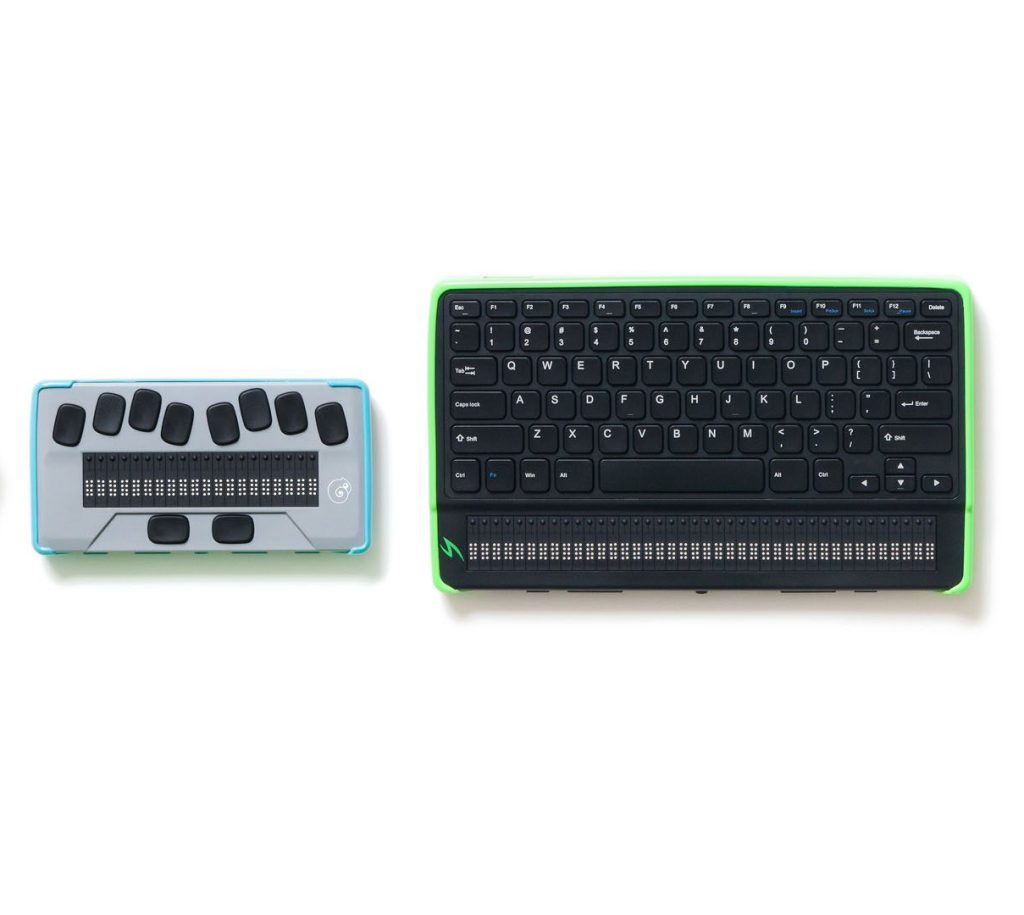To ensure gift delivery by 12/25, please place orders via UPS shipping no later than 12/17.
CloseFAQ: Transcribing Textbooks for APH

September 8, 2019
- Organization name, contact info and role within the company.
Jane E. Thompson
Director of Accessible Textbook Division
American Printing House for the Blind
1839 Frankfort Avenue, Louisville, KY 40206, 800-223-1839 - Role:
My role at APH is to identify NLS Certified Transcribers and evaluate their skills to hire as contractual staff for transcribing braille textbooks. - Do your braillist employees work at your company or do they contract with your organization? Are contracts short or long term contracts (book by book or time-limited)?
The transcribers we hire outside the company are contractual, they are not employees of APH and they do not receive benefits from APH. The contracts are on a book by book basis. No one is guaranteed full time or year-long work. - Are your transcribers required to live in your area or can they live anywhere in the US? Other countries?
Due to today’s technology contractual transcribers can work off-site in any state or most any country. - How do I become a transcriber for your organization?
To become a contractual transcriber for APH you must submit the following:- A cover letter detailing your transcription experience with references
- A 20-30 braille page sample (either electronically or hard copy) Textbook materials preferred
- The print pages to match the braille
- Samples of your tactile graphics if you do them
- The print pages to match your graphic samples
- Copies of all NLS Certifications or NBA Certification
- Do you require NLS certifications to work for your organization? Do you require NBA Formats certifications? Course completion? Other certifications?
We only contract with NLS Certified Transcribers and we do give preference to NBA Format Certified or confirmed NBA course completion transcribers. - Does your organization provide NIMAS files to transcribers or scanned files?
When contracting with APH we provide any electronic files we can obtain including NIMAS, publisher, or scanned files. - Are the materials you contract out marked up/edited prior to sending them out to be transcribed? Who do I call if I have questions regarding formatting?
It is our goal to edit all print textbooks prior to shipping to the transcriber we have contracted with, unfortunately, that does not always happen. However, we do provide our Textbook Specifications with every book along with samples of pages that you may need. We also designate an editor for every textbook for braille and tactile graphics, to work with you so you can always contact them with questions, comments or suggestions via email or phone. - How do you assign transcription projects? Bid process?
Once you are accepted as a contractual transcriber and all paperwork is into our company, your name is put into the rotation. The more certifications you have the more your name will come up to receive bids. If you are Nemeth certified you will often get contacted more than if you only have one certification, same with NBA Formats certification.Our Braille Textbook Coordinator estimates the number of braille pages, graphics, and volumes for each book. She also copies 10 pages from the book and at that point we choose 3-5 outsources to fax the bid to. You have 48 hours to return a bid price per page and for the total project. A decision is made within 24 hours and you will be notified if you have received the project or not. The project will ship the next day. - How much time do you give the transcriber to turn their work in?
Each project has a different timeline but as a rule, we ask for the first three volumes in the first month and then three volumes every two weeks after that until the book is complete. Some exceptions may be made. - Do you require proofreading or do you do your own proofreading? Who pays the proofreader?
If you bid on a project you are required to have your own proofreading service and the cost of it must be built into the cost per page that you bid. You are responsible for paying the proofreader. If you do not have a proofreader you may still bid on the project but you must disclose that you have no proofreader, if we can find one we may be able to link the two of you together. - Do you require your transcribers to create tactile graphics? What style of graphics do you accept?
We encourage all transcribers to either create their own graphics or at least find someone that you can work with to do them. If you do not create tactile graphics you may still bid on a project and if we can find someone to work with you we will link the two of you together.We accept several production methods of tactile graphics, electronic files, collage, spur wheel, foil. We can also accept Tiger graphics if they are embellished and are able to be thermoformed. We do not use swell paper graphics. All master graphics and translations become the property of APH. - What translation software do you accept?
Transcribers may use most any software because we require the final product to be sent in as a brf (braille ready file). We prefer Braille 2000, Duxbury, Megadots or Edit PC. No hard copy braille is to be sent. - Do you offer any training at your facility or is it up to the transcriber to provide training?
We offer training every few years, either by webcast or at APH in Kentucky or in conjunction with a professional braille conference. We do travel to two prisons per year to offer training to inmates of programs we contract with. We also offer one on one consultation with transcribers who we have contracted a braille textbook project with. - Can I split the book with another transcriber if I need to? Do you need to have their information as well?
When a textbook project is assigned we sign a contract with the approved transcriber. If you choose to split the book up among other transcribers that is your choice; just be aware that you are the one responsible to turn in a seamless project to us and we will only pay you. So if the work is not acceptable you will not get paid until you make it right. - Do you pay transcribers? How much?
We do pay transcribers, the compensation is based on the complexity of the material, code required, number of tactile graphics, how big the project is and your work history with our company. Our average pay scale is as follows:- Literary $0 – $4/page
- Nemeth $0 – $7/page
- Tactile Graphics $0 – 7/page (varies depending on the production method and complexity of material)
- How often do you pay your transcribers?
At the beginning of each textbook project, the transcriber can choose to send an invoice in with each shipment or wait and bill at the end of the project. We process invoices daily and they are generally paid within 10 days but we do have a 30-day net pay policy. The only caveat to that is if you turn your work in with an invoice and the work is not to our standards we will ask that you correct your work prior to receiving payment for it. - If I get approved to work with you am I assured work 12 months a year?
No. We encourage approved transcribers to keep us informed of their capacity but we cannot guarantee work. We take textbook orders all year long but we never know when they will come in. Currently, we have an approved roster of around 300 transcribers and we try to rotate the names and give work to as many people as possible. - Do you provide materials such as graphic supplies, shipping boxes, and software if I transcribe for you?
No, costs for the aforementioned are covered by APH. These costs are considered the responsibility of the contracted transcriber. If however, you are a volunteer transcriber, we will supply paper, shipping materials, and some supplies in kind for the braille transcription.
Still have questions? Email brailletextbooks@aph.org
Share this article.
Related articles

eBraille: Inception to Reality
A new file standard will soon be available for braille readers! Created by APH and partners around the world, eBraille...

Literacy for the Nation: APH’s Braille Transcriber Apprenticeship Program (BTAP) Offers Ex-Offenders a Hand-Up
Imagine what it would be like to be shut off from the outside world for decades, only to find that...

Summer Reading Program
Summer is a wonderful time of year when the weather is hot and the kids are out of school, so...
